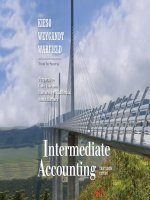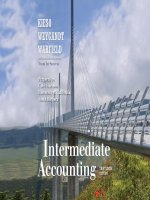Intermediate accounting 13th kieso warfield chapter 11
Bạn đang xem bản rút gọn của tài liệu. Xem và tải ngay bản đầy đủ của tài liệu tại đây (1.03 MB, 57 trang )
Chapter
11-1
CHAPTER
11
DEPRECIATION, IMPAIRMENTS,
AND DEPLETION
Intermediate Accounting
13th Edition
Kieso, Weygandt, and Warfield
Chapter
11-2
Learning
Learning Objectives
Objectives
1.
Explain the concept of depreciation.
2.
Identify the factors involved in the depreciation process.
3.
Compare activity, straight-line, and decreasing-charge methods
of depreciation.
4.
Explain special depreciation methods.
5.
Explain the accounting issues related to asset impairment.
6.
Explain the accounting procedures for depletion of natural
resources.
7.
Explain how to report and analyze property, plant, equipment,
and natural resources.
Chapter
11-3
Depreciation,
Depreciation, Impairments,
Impairments, and
and Depletion
Depletion
Depreciation
Impairments
Depletion
Factors involved
Methods of
depreciation
Special methods
Recognizing
impairments
Measuring
Impairments
Restoration of
loss
Assets to be
disposed of
Establishing a
base
Write-off of
resource cost
Estimating
reserves
Liquidating
dividends
Continuing
controversy
Special issues
Chapter
11-4
Presentation
and Analysis
Presentation
Analysis
Depreciation
Depreciation -- Method
Method of
of Cost
Cost Allocation
Allocation
Depreciation is the accounting process of allocating
the cost of tangible assets to expense in a systematic
and rational manner to those periods expected to
benefit from the use of the asset.
Allocating costs of long-term assets:
Fixed assets = Depreciation expense
Intangibles = Amortization expense
Natural resources = Depletion expense
Chapter
11-5
LO 1 Explain the concept of depreciation.
Depreciation
Depreciation -- Method
Method of
of Cost
Cost Allocation
Allocation
Factors Involved in the Depreciation Process
Three basic questions:
(1) What depreciable base is to be used?
(2) What is the asset’s useful life?
(3) What method of cost allocation is best?
Chapter
11-6
LO 2 Identify the factors involved in the depreciation process.
Depreciation
Depreciation -- Method
Method of
of Cost
Cost Allocation
Allocation
Factors Involved in the Depreciation Process
Depreciable Base
Illustration 11-1
Chapter
11-7
LO 2 Identify the factors involved in the depreciation process.
Depreciation
Depreciation -- Method
Method of
of Cost
Cost Allocation
Allocation
Factors Involved in the Depreciation Process
Estimation of Service Lifes
Service life of an asset often differs from its
physical life.
Companies retire assets for two reasons:
physical factors (such as casualty or
expiration of physical life) and
economic factors (obsolescence).
Chapter
11-8
LO 2 Identify the factors involved in the depreciation process.
Depreciation
Depreciation -- Method
Method of
of Cost
Cost Allocation
Allocation
Methods of Depreciation
The profession requires the method employed be
“systematic and rational.” Examples include:
(1)
Activity method (units of use or production).
(2) Straight-line method.
(3) Sum-of-the-years’-digits.
(4) Declining-balance method.
(5) Group and composite methods.
(6) Hybrid or combination methods.
Chapter
11-9
Accelerated methods
Special methods
LO 3 Compare activity, straight-line, and decreasingcharge methods of depreciation.
Depreciation
Depreciation -- Method
Method of
of Cost
Cost Allocation
Allocation
Activity Method
Illustration 11-2
Stanley Coal
Mines Facts
Illustration: If Stanley uses the crane for 4,000 hours
the first year, the depreciation charge is:
Illustration 11-3
Chapter
11-10
LO 3 Compare activity, straight-line, and decreasingcharge methods of depreciation.
Depreciation
Depreciation -- Method
Method of
of Cost
Cost Allocation
Allocation
Straight-Line Method
Illustration 11-2
Stanley Coal
Mines Facts
Illustration: Stanley computes depreciation as follows:
Illustration 11-4
Chapter
11-11
LO 3 Compare activity, straight-line, and decreasingcharge methods of depreciation.
Depreciation
Depreciation -- Method
Method of
of Cost
Cost Allocation
Allocation
Decreasing-Charge Methods
Illustration 11-2
Stanley Coal
Mines Facts
Sum-of-the-Years’-Digits. Each fraction uses the sum of
the years as a denominator (5 + 4 + 3 + 2 + 1 = 15). The
numerator is the number of years of estimated life
remaining as of the beginning of the year.
Chapter
11-12
LO 3 Compare activity, straight-line, and decreasingcharge methods of depreciation.
Depreciation
Depreciation -- Method
Method of
of Cost
Cost Allocation
Allocation
Sum-of-the-Years’-Digits
Illustration 11-6
Chapter
11-13
LO 3 Compare activity, straight-line, and decreasingcharge methods of depreciation.
Depreciation
Depreciation -- Method
Method of
of Cost
Cost Allocation
Allocation
Decreasing-Charge Methods
Illustration 11-2
Stanley Coal
Mines Facts
Declining-Balance Method.
Utilizes a depreciation rate (percentage) that is some
multiple of the straight-line method.
Does not deduct the salvage value in computing the
depreciation base.
Chapter
11-14
LO 3 Compare activity, straight-line, and decreasingcharge methods of depreciation.
Depreciation
Depreciation -- Method
Method of
of Cost
Cost Allocation
Allocation
Declining-Balance Method
Illustration 11-7
Chapter
11-15
LO 3 Compare activity, straight-line, and decreasingcharge methods of depreciation.
Depreciation
Depreciation -- Method
Method of
of Cost
Cost Allocation
Allocation
E11-5 (Depreciation Computations—Four Methods): KC
Corporation purchased a new machine for its assembly process on
August 1, 2010. The cost of this machine was $150,000. The
company estimated that the machine would have a salvage value of
$24,000 at the end of its service life. Its life is estimated
at 5 years and its working hours are estimated at 21,000 hours.
Year-end is December 31.
Instructions: Compute the depreciation expense under the
following methods.
(a) Straight-line depreciation.
(c) Sum-of-the-years’-digits.
(b) Activity method
(d) Double-declining balance.
Chapter
11-16
LO 3 Compare activity, straight-line, and decreasingcharge methods of depreciation.
Depreciation
Depreciation -- Method
Method of
of Cost
Cost Allocation
Allocation
Straight-line Method
Chapter
11-17
LO 3 Compare activity, straight-line, and decreasingcharge methods of depreciation.
Depreciation
Depreciation -- Method
Method of
of Cost
Cost Allocation
Allocation
Activity Method
Chapter
11-18
(Assume 800 hours used in 2010)
LO 3
Depreciation
Depreciation -- Method
Method of
of Cost
Cost Allocation
Allocation
Sum-of-the-Years’-Digits Method
Chapter
11-19
5/12 = .416667
7/12 = .583333
LO 3
Depreciation
Depreciation -- Method
Method of
of Cost
Cost Allocation
Allocation
Double-Declining Balance Method
Chapter
11-20
LO 3
Depreciation
Depreciation -- Method
Method of
of Cost
Cost Allocation
Allocation
Special Depreciation Methods
The choice of method depends on the nature of the
assets involved:
Group method used when the assets are similar in
nature and have approximately the same useful lives.
Composite approach used when the assets are dissimilar
and have different lives.
Companies are also free to develop tailor-made
depreciation methods, provided the method results in
the allocation of an asset’s cost in a systematic and
rational manner (Hybrid or Combination Methods).
Chapter
11-21
LO 4 Explain special depreciation methods.
Depreciation
Depreciation -- Method
Method of
of Cost
Cost Allocation
Allocation
Special Depreciation Issues
(1) How should companies compute depreciation for
partial periods?
Companies normally compute depreciation on the
basis of the nearest full month.
(1) Does depreciation provide for the replacement of
assets?
Funds for the replacement of the assets come from
the revenues
(1) How should companies handle revisions in
depreciation rates?
Chapter
11-22
LO 4 Explain special depreciation methods.
Depreciation
Depreciation -- Method
Method of
of Cost
Cost Allocation
Allocation
Changes in Depreciation Rate
Accounted for in the period of change and
future periods (Change in Estimate)
Not handled retrospectively
Not considered errors or extraordinary items
Chapter
11-23
LO 4 Explain special depreciation methods.
Change
Change in
in Estimate
Estimate Example
Example
Arcadia HS, purchased equipment for $510,000 which
was estimated to have a useful life of 10 years with a
salvage value of $10,000 at the end of that time.
Depreciation has been recorded for 7 years on a
straight-line basis. In 2010 (year 8), it is determined
that the total estimated life should be 15 years with a
salvage value of $5,000 at the end of that time.
Questions:
What is the journal entry to correct
the prior years’ depreciation?
Calculate the depreciation expense
for 2010.
Chapter
11-24
No Entry
Required
LO 4 Explain special depreciation methods.
Change
Change in
in Estimate
Estimate Example
Example
After 7 years
Equipment cost
First,
establish
First,
establish
$510,000
NBV
NBV at
atdate
dateof
of
Salvage value
change
changein
inestimate.
estimate.
- 10,000
Depreciable base
x 7 years = $350,000
500,000
Useful life (original)
Balance Sheet (Dec. 31, 2009)
10 years
Fixed Assets:
Annual depreciation
$ 50,000 Equipment
$510,000
Accumulated depreciation
350,000
Net book value (NBV)
Chapter
11-25
$160,000
LO 4 Explain special depreciation methods.









